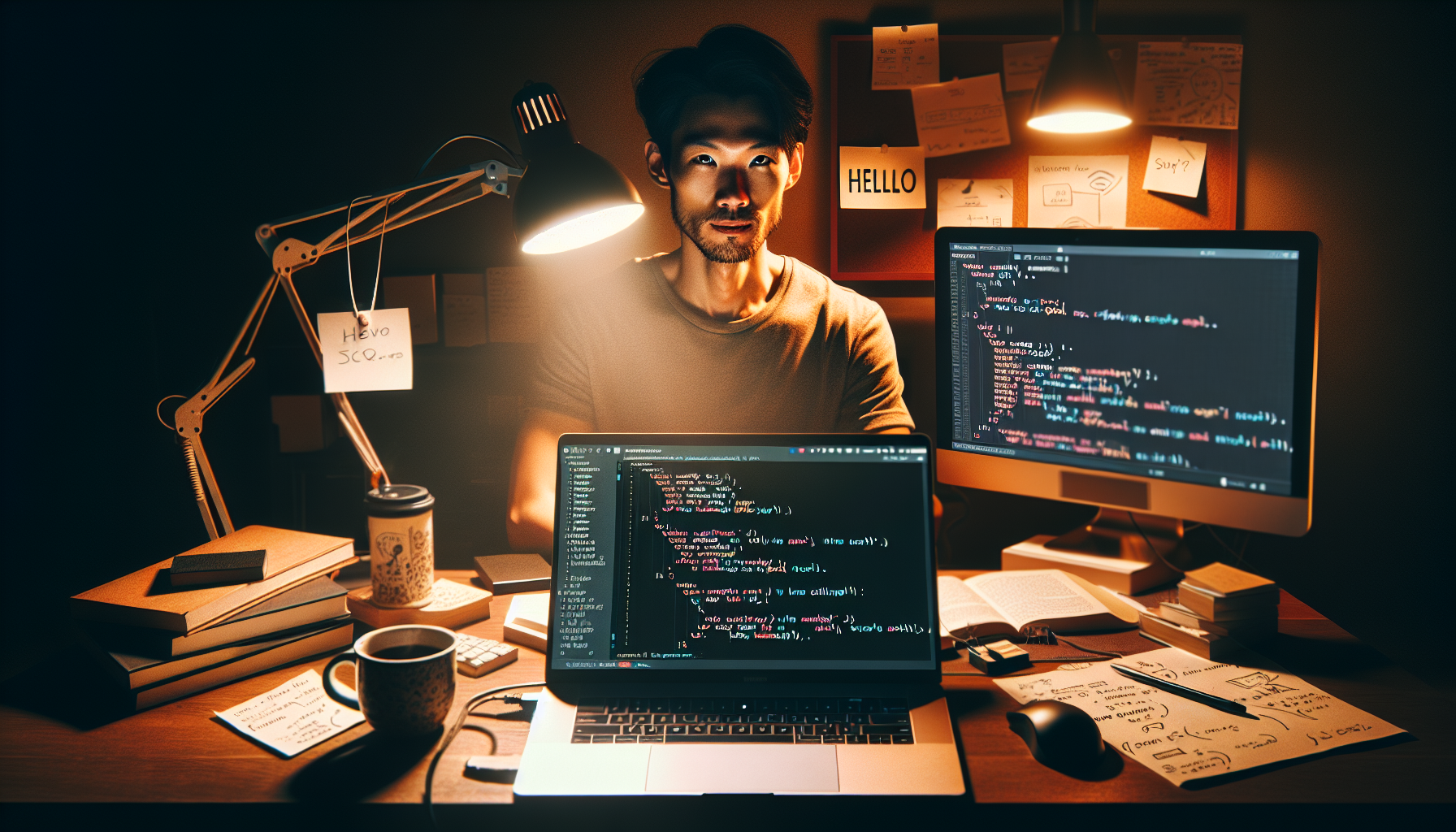Python Programming for Absolute Beginners is a meticulously crafted course designed to guide novices through the exhilarating world of Python coding. Starting from setting up the environment to mastering control flow, this course lays a solid foundation for understanding and utilizing one of the most versatile programming languages today. As we delve into fundamental concepts, write our first programs, and explore Python’s structure, we ensure a hands-on learning experience that’s both comprehensive and engaging for beginners. Join us as we embark on this journey, transforming you from an absolute beginner into a confident coder, ready to tackle the challenges and opportunities Python programming offers.
Lesson 1

Getting Started with Python
Welcome to your first steps in the Python programming world, a journey that will open many doors in technology and software development. This article is dedicated to helping absolute beginners get started with Python, one of the most popular and in-demand programming languages today. Diving into Python programming is an exciting endeavor, and we’re here to guide you through making this process as seamless and engaging as possible.
What is Python and Why Learn It?
Python is a versatile, high-level programming language known for its readability and straightforward syntax. It’s widely used for web development, data analysis, artificial intelligence, scientific computing, and more. Learning Python opens up a world of possibilities in various tech sectors, making it a fantastic choice for beginners aiming to carve out a career in programming.
Setting Up Your Python Environment
Before writing your first line of code, setting up your Python environment is crucial. You’ll need to install Python on your computer. Head over to the official Python website, download the latest version for your operating system, and follow the installation instructions.
Writing Your First Python Program
With Python installed, it’s time to write your first program. Open your text editor or IDE (Integrated Development Environment) and type the following:
print("Hello, world!")Save your file with a .py extension and run it. Congratulations, you’ve just executed your first Python program!
Understanding Syntax and Basic Python Rules
The beauty of Python lies in its simplicity. However, understanding its syntax and basic rules is essential. Here are a few tips:
- Python is case sensitive.
- Indentation is crucial in Python and is used to define blocks of code.
- Comments can be added with the ‘#’ symbol, allowing you to leave notes and explanations in your code.
As you embark on your Python programming journey, remember that practice makes perfect. Experiment with different codes, participate in coding challenges, and never hesitate to seek help from the vibrant Python community. With steadfast dedication and curiosity, your journey from an absolute beginner to a proficient Python programmer will be fulfilling and enjoyable. Welcome aboard!
Lesson 2

Exploring Fundamental Python Concepts
Diving deeper into Python programming embarks you on an exciting journey through its core concepts and structures. This guide aims to illuminate this path for beginners, ensuring a smooth transition into Python’s fundamental elements. With Python’s versatility and simplicity, understanding these basics can significantly empower your coding journey.
Variables and Data Types in Python
At the heart of Python programming are variables and data types. Variables are like containers that store data values. Python, being dynamically typed, does not require explicit declaration to reserve memory space. The declaration happens automatically when you assign a value to a variable:
x = 5
y = "Hello, World!"Python supports various data types, including integers, float (decimal numbers), strings, and more. Embracing these types is crucial for effective data manipulation and operation in Python.
Basic Operators and Expressions
Operators allow you to perform operations on variables and values. Python classifies operators into several categories like arithmetic, comparison, and logical operators. For example:
sum = 5 + 3 # arithmetic addition
equal = (5 == 3) # comparison, yields False
Expressions combine values, variables, and operators to compute a value. Mastering how to use expressions is key to creating dynamic and efficient Python programs.
Introduction to String Manipulation
Strings are sequences of characters and are among the most used data types in Python. Python comes with a powerful set of methods to manipulate strings, allowing you to perform operations like concatenation, slicing, and formatting:
greet = "Hello" + " World" # concatenation
slice = greet[0:5] # slicing
formatted = f"{greet}, it's a pleasure!" # formatting
Understanding how to work with strings is foundational to handling text in Python applications, from simple print statements to complex data processing.
Understanding Python’s Indentation
Unlike many other languages that use braces to define blocks of code, Python uses indentation. A block of code starting with a colon needs to be indented. This not only makes your code visually cleaner but also enforces readability, a core philosophy of Python:
if 5 > 3:
print("Five is greater than three.")
Using indentation correctly is essential for writing error-free Python code.
As you familiarize yourself with these fundamental concepts, remember that the essence of learning Python—or any programming language—lies in practice. Experiment with these concepts, try writing small programs, and soon, you’ll find yourself becoming more comfortable and proficient in Python programming. The journey of mastering Python is a step-by-step process, and you’ve just taken some crucial steps forward. Keep exploring, keep coding, and let Python’s simplicity guide you through your programming journey.
Lesson 3

Mastering Control Flow in Python
Getting comfortable with Python programming is pivotal as you progress, especially when it comes to understanding and implementing control flow. Control flow is the backbone of making decisions in your programs, enabling them to react differently under various conditions and iterate over data sequences. This guide unfolds the essential concepts of control flow in Python, ensuring beginners can take confident steps forward in their Python journey.
Conditional Statements in Python
Conditional statements are your first tool in decision-making with Python. The most basic form, the if statement, evaluates whether a condition is true and, if so, executes a block of code:
if condition:
# block of code to execute if condition is trueFurther, the else and elif (else if) statements allow your program to evaluate multiple expressions and choose different paths accordingly.
Loops in Python
When you need to execute a block of code multiple times, loops come into play. Python offers two types of loops:
forloops, which iterate over a sequence like a list, tuple, or stringwhileloops, which repeatedly execute a block of code as long as a condition is true
Loops are incredibly effective for processing items in a collection, performing repetitive tasks, and automating what would otherwise be a large amount of code.
Using break, continue, and pass Statements
To give you more control over the flow of your loops, Python includes the break, continue, and pass statements:
breakexits the loop immediately, regardless of the iteration numbercontinueskips the rest of the code inside the loop for the current iterationpassdoes nothing but can act as a placeholder in areas where your code will eventually go but has not been written yet
Basic Problem-Solving Exercises
Practical exercises can significantly enhance your understanding of control flow in Python. Here are a few exercises to get you started:
- Create a program that asks for a number and prints whether it’s odd or even
- Write a script that lists all numbers from 1 to 100 that are divisible by 7
- Develop a simple calculator that uses
if,elif, andelsestatements to conduct basic math operations
Through these exercises and a thorough understanding of control flow, you’re well on your way to becoming proficient in Python programming. Remember, the key to mastery lies in practice and perseverance. So, keep experimenting with these concepts, and don’t hesitate to tackle more complex problems as you grow. Your Python programming journey is just getting started, and the possibilities are endless.
Python Programming for Absolute Beginners concludes as a foundational journey into coding, equipping learners with the tools, concepts, and confidence to explore the vast world of Python. From establishing a programming environment to navigating through variables, control flow, and beyond, this course has covered essential territories for budding coders. As you stand at this juncture, ready to dive deeper into Python or perhaps branch out to other languages, remember that the journey of learning is continuous and ever-evolving. To gauge your understanding and solidify the concepts learned, a 10 question quiz awaits below this conclusion. It’s not just a test, but a milestone to celebrate your progress and readiness for the next steps in your programming adventure.
Test Your Knowledge With this short Quiz
Click here to copy your score to share on facebook!







